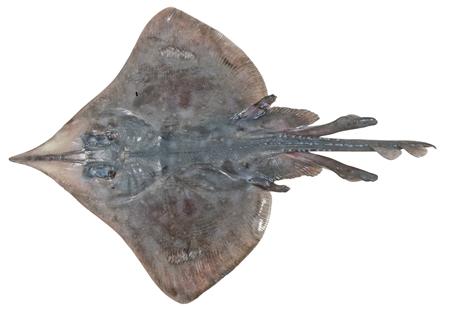100 New Rays and Skates Scientifically Named
Posted by: Loren Coleman on September 18th, 2008

The Maugean Skate, Zearaja maugeana, a new species from Bathurst and Macquarie Harbours in Tasmania is seen in this handout photo released by Commonwealth Scientific and Industrial Research Organization on September 18, 2008.
Australian and other scientists using DNA have catalogued and described 100 new species of sharks and rays in Australian waters.
More than 90 of the newly named species were identified by scientists in a 1994 book Sharks and Rays of Australia but remained scientifically undescribed. One rare species of carpet shark catalogued was found in the belly of another shark. The new names and descriptions will now feature in a revised 2009 edition of the book by Australia’s peak scientific body.
The Commonwealth Scientific & Industrial Research Organization (CSIRO) said its cataloguing of the new species was critical for the management of sharks and rays, which reproduce slowly and are vulnerable to overfishing.

The Southern Dogfish, Centrophorus zeehaani, a new species of gulper shark endemic to southern Australia is seen in this handout photo released by Commonwealth Scientific and Industrial Research Organization on September 18, 2008.
Some of the new species named include:
* The endangered Maugean Skate shark (see, at top), closely related to an ancestor from the Gondwanan period in Australia some 80 million years ago, found at the southwest of the island state of Tasmania. It is one of the only skates in the world found in brackish or freshwater and its survival could be affected by climate change, said the scientists.
* The critically endangered gulper shark or the Southern Dogfish (above), which is endemic to the continental shelf off southern Australia.
* The Northern Freshwater Whipray and the Northern River Shark, which grow to over two meters (six feet) in length, and are among the largest freshwater animals in Australia. Until recently these were confused with similar marine species.
WWF-Australia fisheries manager Peter Trott said confusion between separate species of sharks and rays meant that new, rare or endangered species may be mistaken for more common species and inadvertently taken by fishermen.
“We are literally fishing in the dark when it comes to sharks and rays. In many cases we simply do not know what species we are plucking from Australian waters, Trott said in a statement.
(Sources: CSIRO; Reuters reporter Michael Perry; editor David Fox.)
About Loren Coleman
Loren Coleman is one of the world’s leading cryptozoologists, some say “the” leading living cryptozoologist. Certainly, he is acknowledged as the current living American researcher and writer who has most popularized cryptozoology in the late 20th and early 21st centuries.
Starting his fieldwork and investigations in 1960, after traveling and trekking extensively in pursuit of cryptozoological mysteries, Coleman began writing to share his experiences in 1969. An honorary member of Ivan T. Sanderson’s Society for the Investigation of the Unexplained in the 1970s, Coleman has been bestowed with similar honorary memberships of the North Idaho College Cryptozoology Club in 1983, and in subsequent years, that of the British Columbia Scientific Cryptozoology Club, CryptoSafari International, and other international organizations. He was also a Life Member and Benefactor of the International Society of Cryptozoology (now-defunct).
Loren Coleman’s daily blog, as a member of the Cryptomundo Team, served as an ongoing avenue of communication for the ever-growing body of cryptozoo news from 2005 through 2013. He returned as an infrequent contributor beginning Halloween week of 2015.
Coleman is the founder in 2003, and current director of the International Cryptozoology Museum in Portland, Maine.










Oh boy, more sculpting material for the the fisher folks who blessed us with countless Jennie Hannivers over the centuries. It would be an interesting endeavor for some enterprising biologist to actually sample the DNA of Jennie’s made over the years and see how many “undiscovered species” of skate and ray are on display in countless museums, sideshows, private collections and cabinets of curiosity around the world. Though they are mutilated a bit away from their natural form, mummies like this have a tendency to last for a very long time.
Wow,
Amazing the amount of creatures finally named.